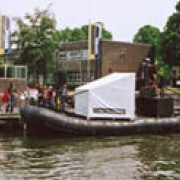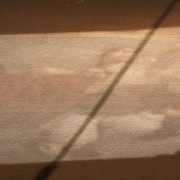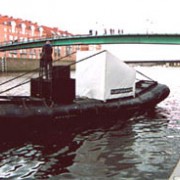FloatScanner



































A participant is invited to make a journey on the canals of the city with a blacked out boat.
He lies on a waterbed in a tent. The waterbed reacts on the movements of the boat, the effect is disorientation.
FloatScanner is a play with two participants:
A participant is invited to make a journey on the canals of the city with a blacked out boat. He lies on a waterbed in a tent. The waterbed reacts on the movements of the boat, the effect is disorientation. For the perception of what is happening outside one is depending on a surveillance camera mounted outside on the boat. The images of the surveillance camera are projected above his head on a projection screen. These images are mixed with what a surveillance camera inside the boat scans; his own body. Thus finding yourself in a closed of space, observing yourself floating in the mediated surrounding of the boat. The body is transferred in to a mediated reality, in which it can float.
The physical experience is detached from the rational understanding of the surrounding. FloatScanner plays with the floating apart of these two worlds, thus making the participant lose more and more control on his surrounding and himself. The identification with a self-center which generates meaning to the world a round us evaporates, disappears.
Floating away on a waterbed, who doesn’t want that? FloatScanner gives you the opportunity; it scans and re-projects your surroundings, while you float away from the shore. But how reliable is this information if your journey is depending on the manipulations of a visitor on the shore? Are you still in control of what you see and experience, while you float away?
Manipulation from the shore:
The process of detachment is manipulated from the shore by a second participant. Images of the surveillance camera’s are send to the shore, manipulated by participant 2 and sent back. This makes the surveillance camera images even more surreal. For the manipulation the second participant has several scenario’s at his disposal.
Lying on the waterbed of boat participant 1 can manipulate the 3 videolayers in the image with a joystick. During the approximately ten minutes trip, both camera's scan the surrounding of the boat and the body of participant 1, thus uncovering meticulous the process of detachment of the body and the surrounding. FloatScanner scans the process of detachment and boundlessness.
FLOATSCANNER INSIDE
FLOATSCANNER PROJECTION TOUCHSCREEN:
Leisure activities have become one of the mayor economic forces, a force that penetrates different levels in our lives. Simultaneously with leisure activities a control-economy became a force that gives direction to the way we live. As with leisure activities these forces determine the way we design our public space. People are looking for new experiences as leisure activities, with the consequence that city-centers change into controlled ‘fairground attractions’.